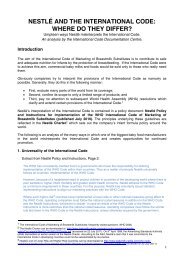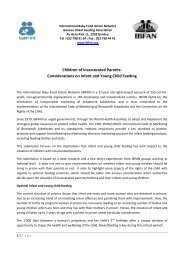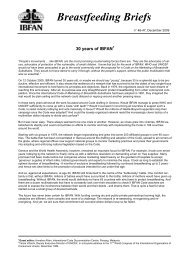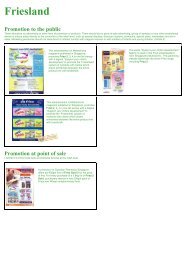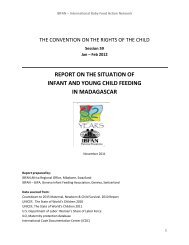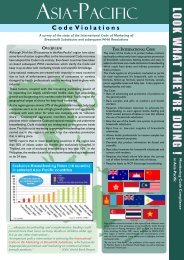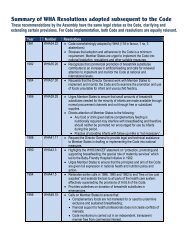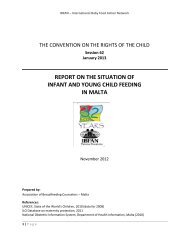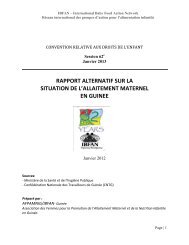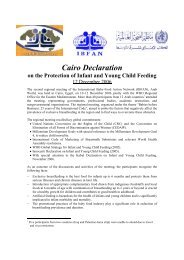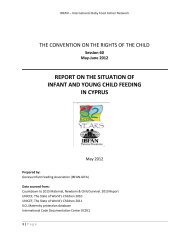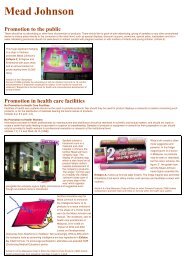Infant and young child feeding in emergencies. Making it ... - IBFAN
Infant and young child feeding in emergencies. Making it ... - IBFAN
Infant and young child feeding in emergencies. Making it ... - IBFAN
Create successful ePaper yourself
Turn your PDF publications into a flip-book with our unique Google optimized e-Paper software.
Day 2<br />
Figure 2: Assessment <strong>in</strong> the context of emergency preparedness <strong>and</strong> response<br />
Pre-Crisis<br />
Emergency<br />
Immediate<br />
Response Phase<br />
Beyond the<br />
Immediate Response<br />
Increas<strong>in</strong>g depth<br />
Preparedness<br />
data collection<br />
Early warn<strong>in</strong>g systems<br />
Surveillance<br />
Periodic surveys<br />
Exist<strong>in</strong>g research/studies<br />
Multi-sectoral<br />
Rapid<br />
Assessment<br />
(qual<strong>it</strong>ative &<br />
secondary.<br />
quant<strong>it</strong>ative)<br />
Sector specific<br />
rapid assessments<br />
Multi-sectoral survey<br />
(probabil<strong>it</strong>y sample):<br />
health/Nutr/Food/<br />
Wash/etc.<br />
In-depth sector studies<br />
quant<strong>it</strong>ative/qual<strong>it</strong>ative<br />
Follow-up survey:<br />
health/Nutr/Food/<br />
Wash/etc.<br />
Preparedness<br />
Mon<strong>it</strong>or<strong>in</strong>g<br />
Sudden<br />
Onset<br />
Performance Mon<strong>it</strong>or<strong>in</strong>g<br />
1wk 6-8 wk 3-6 mo 1 year<br />
The presentations generated a lot of discussion <strong>and</strong><br />
clearly more opportun<strong>it</strong>y to compare experiences <strong>and</strong><br />
reach conclusions on the best way to do IFE assessments is<br />
needed. However some conclusions <strong>and</strong> lessons learned<br />
from the session <strong>in</strong>clude:<br />
• The schematic (Figure 2) of what k<strong>in</strong>d of assessment<br />
to do <strong>and</strong> when <strong>in</strong> the context of an emergency was<br />
judged to be useful by most participants, by<br />
<strong>in</strong>troduc<strong>in</strong>g useful common term<strong>in</strong>ology <strong>and</strong> <strong>in</strong><br />
consider<strong>in</strong>g what type of assessment activ<strong>it</strong>ies should<br />
happen when.<br />
• Different k<strong>in</strong>ds of assessment are needed <strong>and</strong> are<br />
feasible at different times <strong>and</strong> there is no hard <strong>and</strong> fast<br />
rule on exactly what to do <strong>and</strong> when. However th<strong>in</strong>gs<br />
to keep <strong>in</strong> m<strong>in</strong>d are:<br />
– To be clear on the objectives of the assessment/<br />
survey<br />
– Methodology adopted should depend on the<br />
objective, the way the <strong>in</strong>formation will be used <strong>and</strong><br />
conisder logistics, feasibl<strong>it</strong>y, resources, etc.<br />
– To collect only the most necessary <strong>in</strong>formation for<br />
programme plann<strong>in</strong>g – less is often more. The<br />
temptation is often to use the ‘opportun<strong>it</strong>y’ to<br />
collect a lot of IYCF data, but much of this may not<br />
be relevant for programme plann<strong>in</strong>g <strong>in</strong> the<br />
immediate s<strong>it</strong>uation <strong>and</strong> thus wastes time <strong>and</strong><br />
resources.<br />
– Wherever possible, st<strong>and</strong>ard IYCF <strong>in</strong>dicators <strong>and</strong><br />
methodologies should be used to facil<strong>it</strong>ate<br />
comparison w<strong>it</strong>h pre-emergency data <strong>and</strong> other<br />
surveys/assessments.<br />
– At any stage of the assessment process, consideration<br />
of adequate sample size is important – this has<br />
implications for cost <strong>and</strong> feasibil<strong>it</strong>y but also for<br />
what can eventually be done w<strong>it</strong>h the data<br />
collected (e.g. will the precision be adequate for the<br />
objectives of the survey?)<br />
– Undertak<strong>in</strong>g assessments is often hampered by<br />
access to the area, availabil<strong>it</strong>y of data collectors,<br />
status of potential respondents, time for<br />
preparation, resources – this affects tim<strong>in</strong>g of the<br />
assessments, what can be done <strong>and</strong> when.<br />
– A balance is needed between spend<strong>in</strong>g time <strong>and</strong><br />
resources on assessments vs. implement<strong>in</strong>g<br />
<strong>in</strong>terventions. However, some amount of data can<br />
greatly improve the qual<strong>it</strong>y of <strong>in</strong>terventions <strong>and</strong><br />
also provide mon<strong>it</strong>or<strong>in</strong>g <strong>and</strong> evaluation of data for<br />
programme managers, donors, etc.<br />
4.5 Session 8: Challenge of<br />
communication <strong>in</strong> <strong>emergencies</strong><br />
Karleen Gribble (Univers<strong>it</strong>y of Western Sydney) presented<br />
a case study from Bangladesh after Cyclone Sidr <strong>in</strong> 2007<br />
<strong>and</strong> Anton Susanto of UNICEF Indonesia described the<br />
process of develop<strong>in</strong>g communications materials after the<br />
Yogjakarta earthquake <strong>in</strong> 2006.<br />
Karleen reported on the large number of media reports<br />
on government or mil<strong>it</strong>ary donations of BMS or requests<br />
for BMS. She also showed that some aid agencies had<br />
provided or requested BMS. Meanwhile, s<strong>it</strong>uation reports<br />
lamented the lack of <strong>in</strong>fant formula/’baby foods’ <strong>and</strong><br />
talked about mothers’ <strong>in</strong>abil<strong>it</strong>y to breastfeed. There were<br />
no reports, however, on the fact that breast<strong>feed<strong>in</strong>g</strong><br />
supports <strong>child</strong> survival, that <strong>in</strong>fant formula <strong>and</strong><br />
powdered milks need to be carefully targeted, or the risks<br />
of artificial <strong>feed<strong>in</strong>g</strong>. Karleen then emphasised that while<br />
the media is currently contribut<strong>in</strong>g to calls for donations<br />
<strong>and</strong> perpetuat<strong>in</strong>g misconceptions about IFE, there is a big<br />
potential to use the media to improve IFE. But cr<strong>it</strong>ically,<br />
the message we send out to the media needs to emphasise<br />
the risks of artificial <strong>feed<strong>in</strong>g</strong> <strong>in</strong> <strong>emergencies</strong>, rather than<br />
just extoll<strong>in</strong>g on the benef<strong>it</strong>s of breast<strong>feed<strong>in</strong>g</strong>.<br />
Anton Susanto described an <strong>in</strong><strong>it</strong>iative called CREATE<br />
(Communication Resources Essentials <strong>and</strong> Tools for<br />
12



